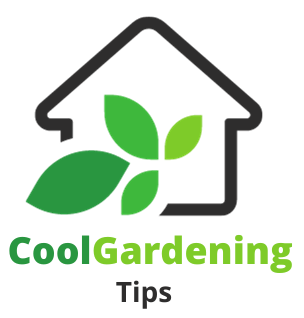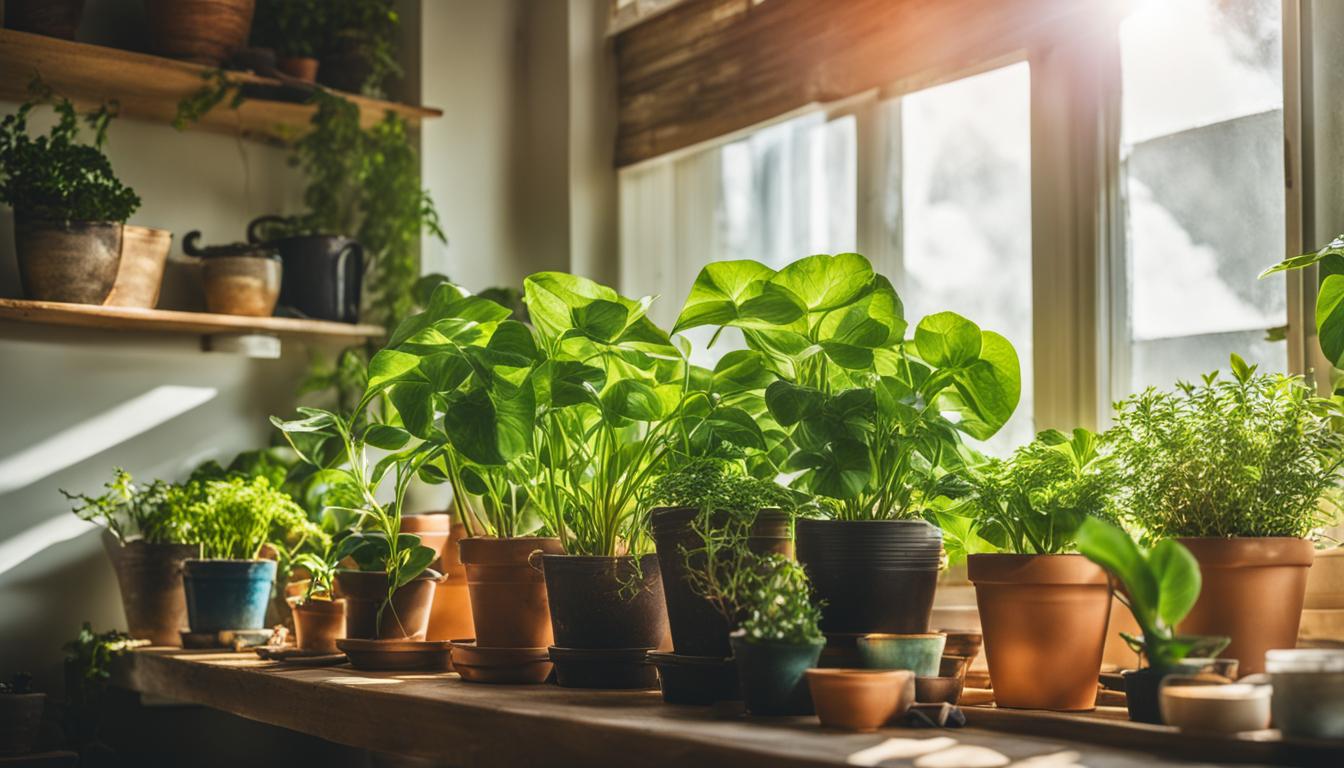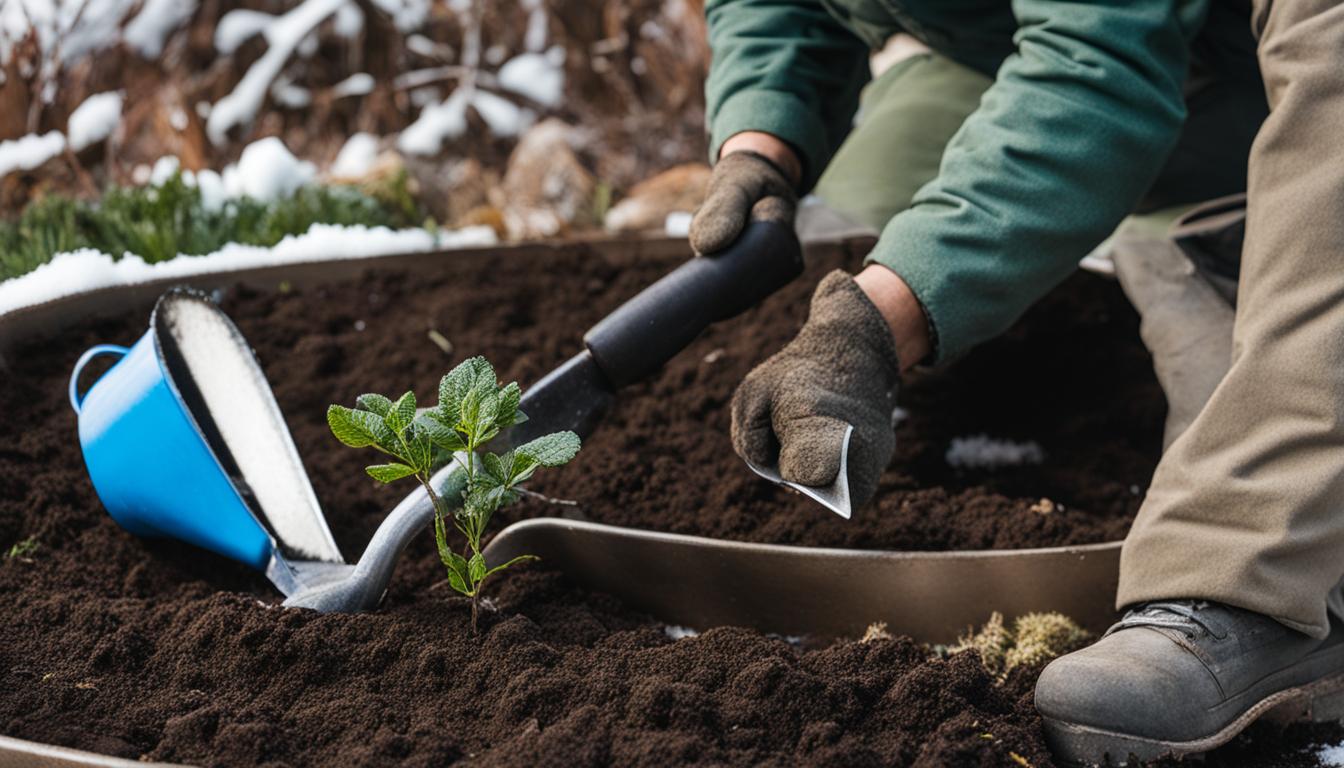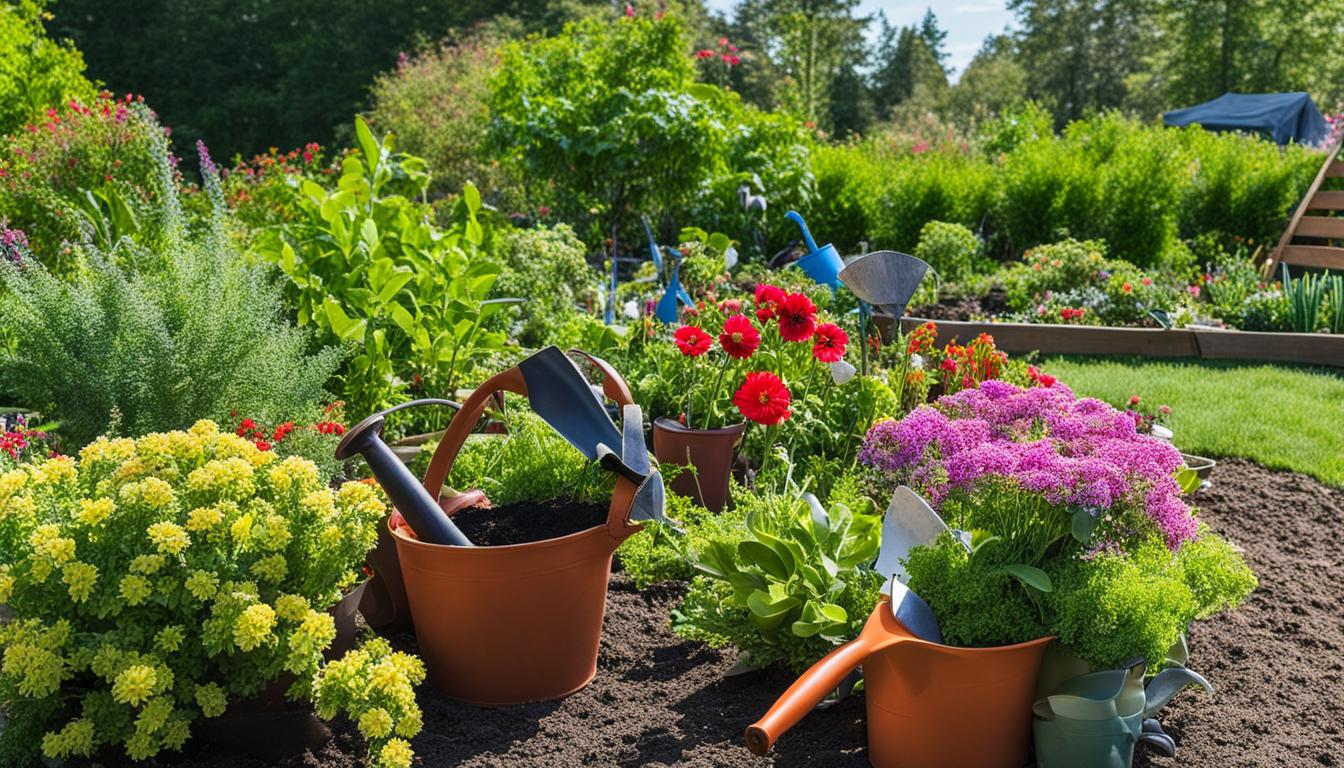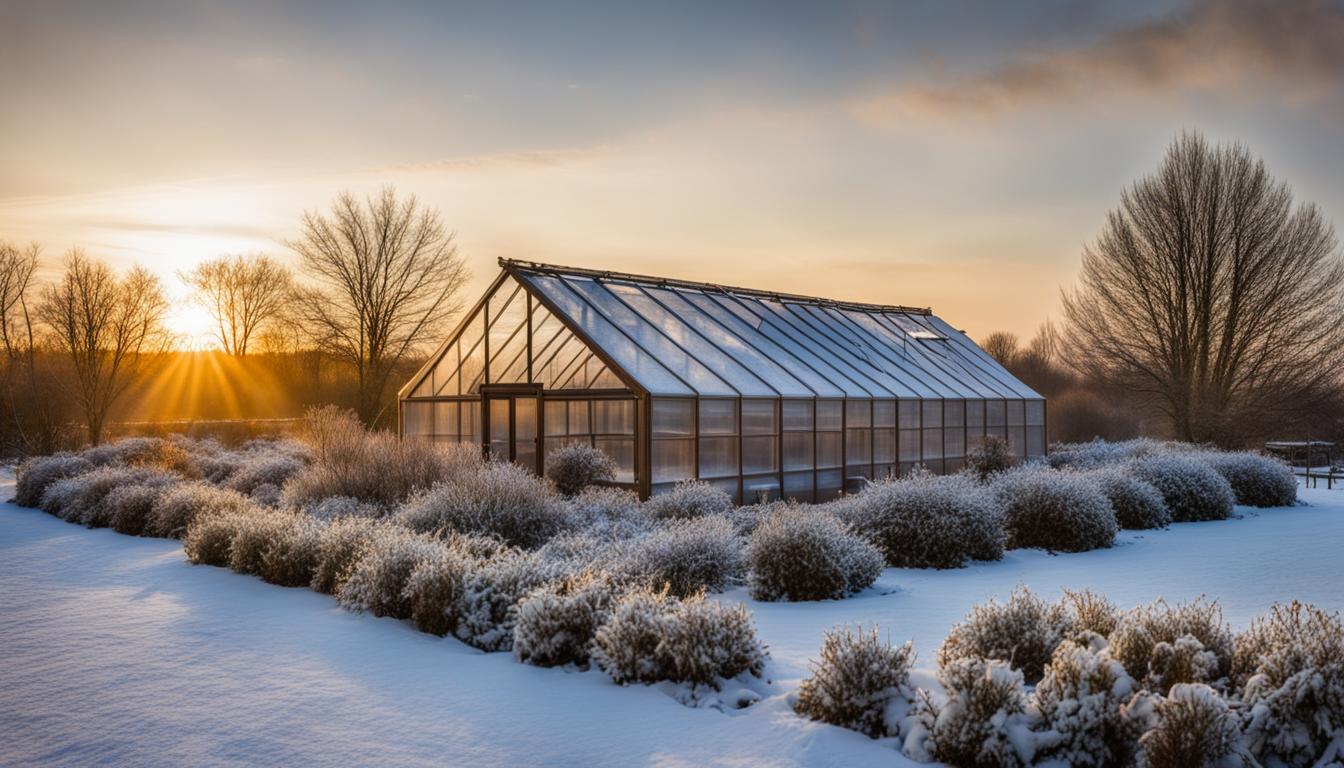Gardening is a great way to add life and vitality to any space, but what do you do when you don’t have an outdoor garden? The answer is simple: indoor gardening! Whether you’re limited on outdoor space or prefer the convenience of growing plants indoors, indoor gardening is an excellent way to stay connected with nature and enjoy the benefits of greenery. In this section, I will share some top tips for successful indoor gardening that will help you thrive in your inner greening.
Indoor gardening can be tricky, but it doesn’t have to be. With a little bit of effort and know-how, anyone can create a thriving indoor garden. Whether you’re a beginner or have some experience, these tips will help you get a head start on your indoor gardening journey.
If you’re new to indoor gardening, don’t worry! Indoor gardening is a fun and rewarding hobby that anyone can enjoy. With the right tools and some basic knowledge, you can create a beautiful indoor garden that will brighten up your space and bring you joy.
So, let’s get started! In the next sections, we will discuss how to choose the right indoor plants for your space, understand lighting requirements, create the perfect indoor garden environment, control watering and moisture levels, choose the right containers and soil, fertilize and manage nutrients, prevent and manage pests and diseases, and prune and maintain your indoor plants. By following these tips for indoor gardening, you’ll be on your way to creating a thriving indoor garden in no time.
Are you ready to start your indoor gardening journey? Let’s dive in!
Choose the Right Indoor Plants for Your Space
When it comes to indoor gardening, choosing the right plants is key to success. Not all indoor plants are created equal, so it’s essential to learn about different types of indoor plants and pick ones that suit your space, light conditions, and preferences.
First, consider the size and layout of your indoor space. While small houseplants are perfect for windowsills and desks, larger plants like fiddle leaf figs and snake plants need more room to grow. Additionally, think about the aesthetic you’re trying to achieve, whether it’s a jungle-inspired oasis or a minimalist collection of succulents.
Once you have a sense of your space and style, it’s time to investigate different indoor plants. Some popular options include:
| Plant Name | Light Requirements | Benefits |
|---|---|---|
| Spider Plant | Bright, indirect light | Air-purifying |
| Pothos | Low to medium light | Low-maintenance |
| Rubber Plant | Bright, indirect light | Easy to care for |
| ZZ Plant | Low to bright, indirect light | Drought-tolerant |
Remember to take your own living environment into account as well. If you have pets or children, avoid plants that are toxic when ingested, such as philodendrons and pothos. On the other hand, if you have a furry friend who loves to nibble on greenery, consider pet-friendly plants like spider plants and Boston ferns.
By carefully selecting the right indoor plants for your space, you’ll be well on your way to a thriving indoor garden filled with beautiful houseplants.
Understand Lighting Requirements
When it comes to indoor gardening techniques, understanding lighting requirements is crucial. Different plants have different light requirements, and providing them with the right amount of light is essential for their growth.
First, it’s important to determine how much natural light your space receives. Place a light meter near your plants to measure the amount of light they are getting. Alternatively, you can use a smartphone app to determine light levels.
Next, research the lighting requirements of your indoor plants. Some plants require direct sunlight, while others thrive in low light conditions. Make sure to place your plants in areas that receive the appropriate amount and type of light.
Types of Light
There are three main types of light: natural light, artificial light, and a combination of both.
Natural light is the best source of light for most indoor plants. However, not all homes or offices have enough natural light to sustain plant growth. In this case, artificial light sources can be used to supplement or replace natural light.
When using artificial light, it’s important to consider the intensity and duration of the light. Plants require a certain amount of light per day to grow, and the intensity of light affects their growth rate. A timer can be used to ensure the plants receive the necessary amount of light for optimal growth.
Choosing the Right Light Bulbs
Choosing the right light bulbs is essential for indoor gardening success. LED bulbs are the most energy-efficient and can provide the full spectrum of light required for plants. Fluorescent bulbs are also suitable for indoor gardening but tend to be less efficient.
It’s important to note that different plants require different color spectrums of light. For example, plants that require direct sunlight thrive with blue light, while plants that grow in low light conditions do better with red light.

Remember to monitor your plants regularly to ensure they are receiving the right amount and type of light for optimal growth.
Create the Perfect Indoor Garden Environment
Indoor plants are more delicate than their outdoor counterparts. To create an ideal environment for your indoor garden, you need to control three essential factors: temperature, humidity, and airflow.
Temperature
The average temperature in most homes is suitable for many indoor plants. However, some plants require specific temperature ranges. For instance, succulents prefer temperatures between 60-80°F, while ferns thrive in cooler temperatures of around 50-60°F. Make sure you understand the temperature requirements of your plants and adjust your thermostat accordingly.
Humidity
Low indoor humidity often leads to plant problems, such as brown leaf tips, wilting, and stunted growth. You can increase humidity by placing a humidifier near your plants or creating a pebble tray. To make a pebble tray, fill a shallow tray with pebbles and water, then place the plant on top. As the water evaporates, it creates a humid microclimate around your plant.
Airflow
Good airflow helps prevent pest and disease problems and encourages healthy plant growth. You can improve the airflow in your indoor garden by opening windows, using a fan, or placing plants near air vents. However, avoid placing plants in drafty areas or near doors that open frequently.
By optimizing the temperature, humidity, and airflow in your indoor garden, you create the perfect conditions for your plants to thrive. Keep an eye on these factors regularly and adjust them as necessary to ensure your plants stay healthy.
“Controlling temperature, humidity, and airflow is essential to create the perfect indoor gardening environment.”
Watering and Moisture Control
Proper watering is essential for indoor plants. Overwatering or underwatering can damage or even kill your plants. Here are some essential indoor gardening techniques and tips to help you maintain the right moisture levels.
| Watering Techniques | When to Water |
|---|---|
| Bottom-up watering | When the soil is dry to the touch, and the plant shows signs of wilting |
| Top-down watering | When the soil surface is dry to the touch |
| Self-watering | When the water reservoir is empty or almost empty |
When watering indoor plants, it’s essential to use room-temperature water to avoid shocking the roots. Additionally, avoid getting water on the leaves of your plants, as this can encourage fungal growth and other issues.
To maintain the right moisture levels, consider using a moisture meter or inserting your finger to a depth of about an inch into the soil. If the soil feels dry, water your plants. However, if it feels moist, hold off on watering until the soil dries out a bit more.
Another key aspect of moisture control is ensuring proper drainage. Make sure your containers have drainage holes and that excess water can flow out. If you notice water pooling at the bottom, it’s a sign that your container may not have adequate drainage.

Overall, watering and moisture control are indoor gardening essentials that can make or break your plant’s health. With these indoor gardening techniques and tips, you can maintain the right moisture levels and avoid overwatering or underwatering your plants.
Picking the Right Containers and Soil
Another essential aspect of indoor gardening is selecting the right containers and soil. The choice of container and soil can affect the growth, development, and health of your indoor plants.
When selecting containers, choose ones that fit the size of your plant’s root system and provide enough drainage. Containers made of porous materials like clay or terracotta can help regulate moisture levels. On the other hand, plastic containers are lightweight and easy to move around, making them convenient for larger plants.
When it comes to soil, avoid using garden soil, which can be too heavy and may contain pests or pathogens. Instead, select a high-quality potting mix that is specifically formulated for indoor plants. Look for mixes that retain moisture but also provide adequate drainage.
Benefits of Choosing the Right Containers and Soil
Choosing the right containers and soil can have significant benefits, such as:
- Promoting healthy root growth
- Preventing waterlogging and root rot
- Allowing for proper drainage and aeration
- Reducing the risk of pests and diseases
By carefully selecting the appropriate containers and soil for your indoor plants, you can help them thrive and reach their full potential.
“The right container can make all the difference in the health of your indoor plants.”
Fertilizing and Nutrient Management
Indoor plants, just like outdoor ones, require proper feeding to stay healthy and grow. Fertilizers and nutrients are essential components of indoor gardening techniques, and it is crucial to understand how to use them effectively.
There are different types of fertilizers, including liquid and granular ones. Liquid fertilizers are ideal for indoor plants, as they are easily absorbed and can be applied directly to the plant’s roots.
When it comes to nutrient management, it is essential to provide your indoor plants with the right balance of minerals and trace elements. Nutrient deficiencies can lead to stunted growth, yellow leaves, and poor flowering.
Indoor gardening essentials include knowing when and how much to fertilize your plants. Overfertilizing can lead to salt buildup in the soil, which can damage plant roots. Underfertilizing, on the other hand, can lead to nutrient deficiencies.
To ensure proper nutrient management, it is essential to follow the manufacturer’s instructions for your chosen fertilizer. You can also use soil tests to determine the nutrient levels in your soil and adjust the fertilizer application accordingly.
| Nutrient | Function | Deficiency Symptoms |
|---|---|---|
| Nitrogen (N) | Essential for plant growth and the production of chlorophyll. | Yellowing leaves, stunted growth. |
| Phosphorous (P) | Essential for root development, flowering, and fruiting. | Poor root growth, small leaves and fruits. |
| Potassium (K) | Essential for plant growth, stress tolerance, and disease resistance. | Weak stems, yellowing leaves, poor flowering and fruiting. |
Indoor gardening techniques require comprehensive knowledge about fertilizing and nutrient management. By following these essential tips, you can ensure your indoor plants receive the right balance of nutrients for optimal growth and health.

Pest and Disease Prevention and Management
As an indoor gardener, I know how challenging pests and diseases can be for your plants. That’s why I’m excited to share with you some of my favorite indoor gardening techniques and hacks for preventing and managing common pest and disease problems in your indoor garden.
Prevention is Key
The best way to deal with pests and diseases is to prevent them from happening in the first place. Here are some indoor gardening essentials for pest and disease prevention:
- Use high-quality soil and sterile planting containers to prevent soil-borne diseases.
- Choose disease-resistant plants that are suited to your indoor gardening environment.
- Keep your indoor garden clean and well-ventilated to prevent pests and diseases from taking hold.
- Quarantine new plants before adding them to your indoor garden to ensure they are pest and disease-free.
By following these indoor gardening techniques, you’ll be able to prevent many common pest and disease problems before they even start.
Common Indoor Garden Pests
Despite your best efforts, some pests may still find their way into your indoor garden. Here are some of the most common indoor garden pests and how to deal with them:
| Pest | Description | Indoor Gardening Hacks |
|---|---|---|
| Spider Mites | Tiny pests that suck sap from leaves, causing wilting and discoloration. | Spray plants with a mixture of water and dish soap to get rid of spider mites. |
| Mealybugs | Small, white, fluffy bugs that suck sap and produce a sticky substance that attracts ants. | Dip a cotton swab in rubbing alcohol and apply directly to mealybugs to kill them. |
| Aphids | Small, pear-shaped insects that suck sap from leaves, causing them to curl and turn yellow. | Spray plants with a mixture of water, dish soap, and cayenne pepper to get rid of aphids. |
Remember to always follow the instructions on any pest control products you choose to use.
Common Indoor Garden Diseases
Just like pests, indoor plants can also fall victim to diseases. Here are some of the most common indoor garden diseases and how to deal with them:
| Disease | Description | Indoor Gardening Hacks |
|---|---|---|
| Powdery Mildew | A fungal disease that appears as a white, powdery substance on leaves. | Spray plants with a mixture of water and baking soda to get rid of powdery mildew. |
| Root Rot | A fungal disease that causes roots to become mushy and discolored. | Allow soil to dry out between watering to prevent root rot. |
| Gray Mold | A fungal disease that causes grayish-brown mold to form on leaves and stems. | Remove infected plant parts and improve air circulation to prevent gray mold. |
Pruning and Maintenance
Regular pruning and maintenance are essential for keeping indoor plants healthy and looking their best. Properly caring for your plants will encourage growth and prevent issues from arising. Here are some indoor gardening techniques and essential tips for pruning and maintenance:
1. Deadheading and Pinching
Deadheading is the process of removing dead or dying flowers from a plant to promote new growth and maintain its appearance. Pinching involves removing the tip of a stem to encourage lateral growth, resulting in a fuller, bushier plant.

2. Cleaning and Dusting
Clean indoor plants regularly by wiping their leaves with a damp cloth to remove dust and debris. This will improve their appearance and help them absorb more light and nutrients.
3. Repotting
Indoor plants may outgrow their containers over time, leading to root-bound plants that can’t absorb nutrients effectively. Repot your plants into larger containers as needed, using fresh soil and ensuring adequate drainage for optimal growth.
4. Monitoring for Pests and Diseases
Regularly monitor your indoor plants for signs of pests and diseases, such as yellowing leaves, sticky residue, or mold. Early detection can prevent the spread of issues and save your plants.
5. Adjusting Care Based on the Seasons
Indoor plants may require different care during different seasons. For example, some plants may need less water in the winter, while others may require more frequent fertilizing during the growing season.
By following these indoor gardening techniques and essential tips, you can keep your indoor plants healthy and thriving for years to come. Regular maintenance and care will reward you with beautiful, lush plants that bring joy and life to your home.
Conclusion: My Ultimate Indoor Gardening Guide
Indoor gardening is a fulfilling hobby that offers many benefits. From improving air quality to reducing stress levels, indoor plants have numerous advantages for our health and well-being. By following my top tips for indoor gardening, you can create a thriving indoor garden and enjoy the beauty of nature in your home or office.
Start Small and Build Your Confidence
If you’re new to indoor gardening, start with a few easy-to-care-for plants and gradually add more as you gain experience. Don’t worry if you make mistakes; learning from them is part of the process. With time and practice, you’ll become a pro at indoor gardening.
Explore Different Plant Varieties
With so many indoor plants to choose from, there’s something for everyone. Whether you prefer leafy greens, bright blooms, or succulents, there’s a plant that will suit your style and space. Do your research, read plant labels, and ask for advice at your local nursery to find the perfect plant for you.
Master the Art of Lighting
Lighting is one of the most critical factors in indoor gardening. Each plant has different lighting requirements, so it’s essential to know how much light your plants need and how to provide it. Use a light meter to measure the intensity of light in your space and adjust accordingly.
Create the Ideal Indoor Garden Environment
Control the temperature, humidity, and airflow in your indoor garden to provide the ideal conditions for your plants. Keep an eye on your plants and adjust the environment as necessary to prevent issues.
Water and Feed Your Plants Regularly
Water your plants as needed, and don’t let them sit in standing water. Use a watering can or spray bottle to water your plants gently. Fertilize your plants regularly to provide them with the necessary nutrients for optimal growth.
Prevent and Manage Pests and Diseases
Monitor your plants regularly for pests and diseases. Use natural remedies or commercial pesticides as needed to keep your plants healthy and pest-free.
Maintain Your Plants for Long-Term Success
Regular pruning, cleaning, and maintenance keep your plants healthy and looking their best. Learn how to care for your plants properly to encourage growth and prevent issues.
So there you have it – my ultimate indoor gardening guide. With these tips, you can create a beautiful and thriving indoor garden that brings joy and peace to your life. Happy gardening!
FAQ
What are some tips for successful indoor gardening?
Some tips for successful indoor gardening include selecting the right plants for your space, understanding lighting requirements, creating an optimal indoor garden environment, proper watering and moisture control, choosing the right containers and soil, fertilizing and managing nutrients, preventing and managing pests and diseases, and regular pruning and maintenance.
How do I choose the right indoor plants for my space?
To choose the right indoor plants for your space, consider factors such as light conditions, space availability, and personal preferences. Research different indoor plants and their specific needs to find ones that will thrive in your indoor environment.
What should I know about lighting requirements for indoor plants?
Different indoor plants have varying lighting requirements. Some plants thrive in direct sunlight, while others prefer indirect or low light conditions. It’s important to understand the lighting needs of your plants and provide them with the appropriate amount of light to ensure optimal growth.
How can I create the perfect indoor garden environment?
Creating the perfect indoor garden environment involves controlling factors such as temperature, humidity, and airflow. Maintain a consistent temperature range, provide adequate humidity for your plants, and ensure proper airflow by using fans or opening windows periodically.
What are some watering and moisture control techniques for indoor plants?
Proper watering is crucial for indoor plants. Water your plants when the top inch of soil feels dry, and make sure to drain any excess water to prevent root rot. You can also use moisture meters or self-watering systems to help maintain the right moisture levels.
How do I pick the right containers and soil for indoor gardening?
When choosing containers, consider factors such as drainage holes, size, and aesthetics. Use well-draining soil mixes specifically formulated for indoor plants, as they provide the right balance of nutrients and moisture retention.
How should I fertilize and manage nutrients for indoor plants?
Indoor plants benefit from regular fertilization. Choose a balanced houseplant fertilizer and follow the recommended dosage instructions. Additionally, monitor your plants for nutrient deficiencies and adjust your fertilization routine accordingly.
How can I prevent and manage pests and diseases in my indoor garden?
To prevent pests and diseases, regularly inspect your plants for signs of infestation or illness. Introduce natural pest control methods, such as neem oil or insecticidal soap, and ensure proper plant hygiene by removing dead leaves or debris.
What are some tips for pruning and maintaining indoor plants?
Regular pruning helps promote healthy growth and maintains the shape of your indoor plants. Use clean, sharp tools to trim away dead or overgrown foliage. Additionally, monitor your plants for signs of diseases or pests and take appropriate measures to address any issues.
How can I transform my indoor spaces into lush paradises through indoor gardening?
By following these top tips for indoor gardening, you can create a thriving indoor garden that adds beauty and benefits to your spaces. Embrace the joy of indoor greening and enjoy the serenity and freshness that indoor plants bring to your environment.
